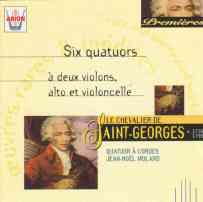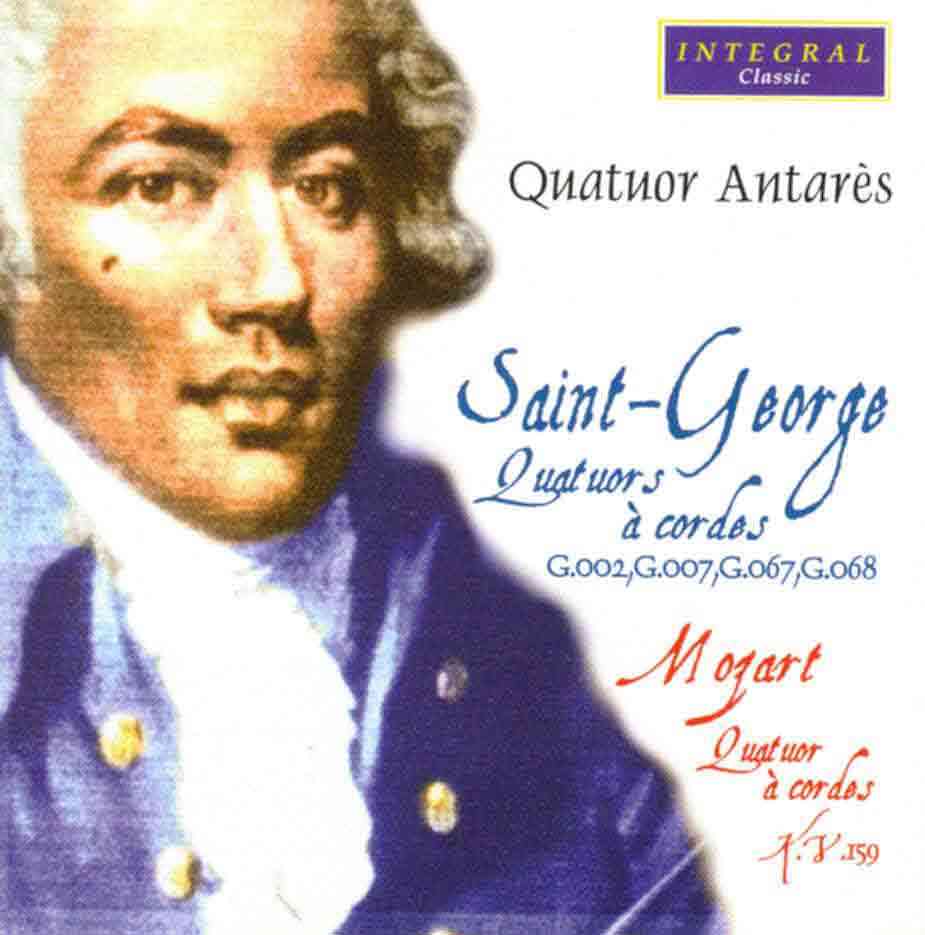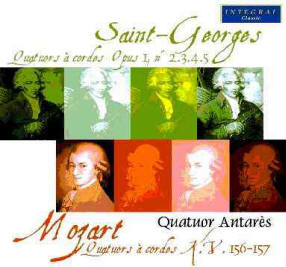Home
Blog
Composers
Musicians
Black History
Audio
About Us
Links
Saint-Georges Biography
Saint-Georges Sub-pages:
Gian Faldoni
Violin Concertos
Symphonies
String Quartets
Harpsichord Sonatas
AfriClassical Blog
Companion to AfriClassical.com
Guest Book
William J. Zick, Webmaster,
wzick@ameritech.net
©
Copyright 2006-2022
William J. Zick
All rights reserved for all content of AfriClassical.com

(1)

(4)

(3)

(5)
|
Home ->
Composers -> Saint-Georges, Le
Chevalier de -> String Quartets
Français
Audio Samples: CDs 3, 4, 5, 6 & 8
(1) Arion 55425 (1998)
No. 1 in C Major, No. 2 in E-flat Major, No. 3 in G Minor,
No. 4 in C Minor, No. 5 in G Minor & No. 6 in D Major
Jean-Noel Molard String Quartet; Arion 55425 (1998).
Violinist Joel-Marie Fauquet writes in the liner notes:
|
Posterity has certainly remembered Saint-Georges, and
the recording which Arion has devoted to four of the twelve
extremely fine violin concertos, show that our attention to
him is fully justified.
Saint-Georges developed the concerto
form according to his own technical
possibilities, but they always give way to the abundance and
charm of his particularly sensitive, eloquent and pungent
melodic gifts, often mingled with a touch of Creole
melancholy. These qualities are also to be found to
the same extent in his chamber music, sonatas and string
quartets. The part
played by Saint-Georges in the development of the quartet in
France is no less eminent since it was with these Six
string quartets here recorded for the first time
by Arion, that Saint-Georges revealed himself to his
contemporaries as a composer. That was in 1773,
Saint-Georges can undoubtedly be placed alongside Francois
Joseph Gossec, his teacher of composition, and Pierre Vachon
(1731-1803) as one of the first exponents of this form.
|
(2) Koch Schwann 3-6411-2 H1 (1996)
Op. 15, No. 6 in G Minor
Joachim Quartet; Koch Schwann 3 6411 2 H1 (1996). Carl de
Nys writes in the liner notes:
|
A new form of chamber music was born and cultivated in France during the second half of the Age of Enlightenment. The rise of the string quartet from the 1770s through to the beginning of the romantic era, cast it firmly in opposition to that of the Viennese School. Two crucial factors provided a catalyst for the rise of a French school of quartets
concertante or "in dialogue", and the fashion for them began to compete with the symphony
concertante, so much appreciated at the time by audiences of the Concert Spirituel and the
Concert des Amateurs. |
(3) Integral Classic A&A007 (2002)
Op. 1. Nos. 2, 3, 4 & 5
String
Quartet in G Major, Op. 1, No. 3
Antarès Quartet; Integral Classic A&A007 (2002)
|
After an initial disc released in May 2002(Integral Classic A&A007), devoted to four
of the earliest string quartets of Saint-Georges and to two of the Milan quartets of Mozart, the Antarès Quartet today presents a new recording (Integral Classic INT 221.125/1) devoted to Chevalier de Saint-Georges and to the young Mozart.
This disc is the second of four volumes which will constitute the complete works for string quartet of Chevalier de Saint-Georges performed by the Antarès Quartet on Integral Classic.
...
For reasons of historical and musical interest, the Antarès Quartet wished to include in these recordings the Milan quartets of Mozart, which were written in the same period of time in which the string quartet was being discovered and defined as a musical genre in its own right.
Although it is not known if they ever met,
Mozart's second trip to Paris took place at a time at which Saint-Georges exercised a very great influence over French musical life.
The liner notes by Alain Guédé provide additional
explanation of the context in which these works were
composed:
Mozart had just left Paris after a series of
setbacks when Saint-George began
composing the six quartets of his second collection. The dark-skinned composer was then at the height of his own fame. In just a few years, he had raised the Concert des Amateurs, to which direction he had succeeded Gossec, to the rank of best European orchestra. His music-making attracted crowds to the Concert Spirituel, and Queen Marie-Antoniette herself attended a number of his performances. Moreover, his opera La Chasse (The Hunt) was performed before the court at Marly and then published
by the King's printer.
Seven years after the first of the metis'
compositions, his style had matured. He had freed himself from the Italian influence which his first musicmaster Leclair had taught him in order to enrich his palette. The harmony was richer and the instruments more readily put into dialogue with each other, rather than being exclusively at the service of the first or
the solo violin.
Subsequently, Guédé turns specifically to String Quartet No.
G. 068:
The faithful will detect an intense spirituality in this work. Freemasons will discover in it a funerary ritual composed by a brother of
the Order. Others again will no doubt see a homage to his brothers in slavery who, some thousands of miles away, succumbed to their commanders' whips. It is true that the melancholy rendered by this adagio could be to classical music what the blues is to jazz.
With the three other quartets by Saint-George selected here by the Antarès String Quartet, we are brought back to the salon music played in literary and artistic circles which was so successful during the Age
of Enlightenment. Music, which illustrates perfectly that period of quest for a better and more enlightened humanity.
...
This second volume of quartets by the so-called "Nègre des Lumières" shows us a
composer who has attained the fullness of his art.
|
|
(5) AFKA Records SK-557 (2003)
No. 1 in B-flat Major, No. 2 in G Minor,
No. 3 in C Major,
No. 4 in F Major, No. 5 in G Major & No. 6 in B-flat Major
String Quartet No. 3
in C Major Sample Time 5:03
Coleridge String Quartet; AFKA SK-557 (2003).
Dominique-René de Lerma, Professor of Music at Lawrence
University, writes in the liner notes:
|
These quartets, never before recorded - and feared lost by some - shed new light on 18th-century France and offer splendid
opportunities for the enhancement of
curricular, broadcasting, and repertoire plans, if not just for an individual's listening pleasure. Their elegant, aristocratic, and wistful moments add substantially to the growing reputation of Saint-Georges, "le nègre des lumières".
The cellist of the Coleridge String Quartet, William E.
Thomas, adds in the liner notes:
These Quartets of the Chevalier de Saint-Georges (Joseph Boulogne), 1745-1799, were thought to be 'lost'. The fact that they are titled
Quartetto Concertants has undoubtedly added to the confusion regarding the nature of these works. They were published in 1779 by Durieu in Paris (rue Dauphine), although some
believe the date of publication to be 1777.
These are extraordinary works. They are not written in the style that was so popular at the time which generally featured the first violin with the other strings taking a supportive role. What we hear instead is a conversation amongst equals. The cello has ample opportunities to 'sing' and carry technically-demanding passages. Equally the viola and second violin are called upon to share melodic material and negotiate the vigorous demands of Saint-Georges' writing.
|
(6) Avenira 276011 (2005)
String Quartets, Op. 14
No. 1 in D Major, No. 2 in B-flat Major, No. 3 in F Minor, No. 4
in G Major, No. 5 in E-flat Major & No. 6 in G Minor
Apollon String Quartet; Avenira 276011 (2005).
String Quartet No. 3 in F Minor
Michelle
Garnier-Panafieu writes in the liner notes:
|
The Quartets
Opus 14: tonalities and
morphology, writing and style
This collection combines, in a manner
very rare at this period, two quartets in
the minor key. It comprises two groups
of three quartets, each consisting of
two works in the major and one in the
minor key; I D major, II B flat major,
III F minor, IV G major, V E flat major,
VI G Minor. In keeping with a practice
that was current in France and
adopted by Saint-George in his
preceding quartets (e.g. Opus 1, Allegro
Rondo or Allegro Minuet) they are all in
two movements, rather short and in the
same key.
Without any indication of tempo, the first movements are
constructed like Allegros in sonata form. The final
movements are more diversified and have dance allusions
(Tempo di minuetto of No IV); they are winsome and
ornamental
variations (Andante con variatione) of No. I and II; or
they are characterised by their dynamism (Vivace and
Allegro of No. III and VI). Saint-George excelled at
handling modal contrasts like so many lighting effects.
The writing is clear and well adapted to the
instruments, the melody tuneful and tender, embroidered
with elegant arabesques of quaver violets; the themes
are gracious and full of charm, endued with a kind of
creole languor and melancholy qualified with a
tenderness that is sometimes almost Mozartian.
Far from being the monopoly of the first
violin, the melodic phrase passes alternately from this
to the second violin and, quite often, to the cello
playing in various registers, or to the viola.
Saint-George likes to repeat his themes, the second time
in a low or high octave.
He uses the procedures of the Mannheim
School (such as the Vorhalt that produces an impression
of painful or solemn insistence) and like Gasviniès and
Le Duc drops languorous touches in the melodic texture.
This succession of Soli - the alternation between
episodes of opposing character (melodically and
rhythmically), the recurrence of sequences designed to
prepare for the entrance of the soloist and his triumphs
of virtuosity, the influence of orchestral writing (in
unison) and vocal music(opera, light opera or love-song)
bestow on his works the concertante style already
referred to.
Inspired by the vocal model, Saint-George seems to go
along with the aesthetic ideas of Rousseau and Diderot
in favour of nature. He was also influenced by the
pre-Romantic aesthetic of Sturm und Drang (note in
particular the quartets in F and G minor), to which most
composers of the period paid
their tribute. |
|
(7) Assai 222622 (2004)
String Quartets, Op. 11
No. 1 in D Major, No. 2 in C-flat Major, No. 3 in F Minor, No.
4 in G Major, No. 5 in E-flat Major & No. 6 in G Minor
Quatuor Atlantis; Assai 222622 (2004)
(8) Integral Classic INT 221.148 (2005)
G.069, G.070, G.071, G.072
String Quartet
in G Major, G.071
Antarès Quartet; Integral Classic
INT 221.148 (2005)
Alain Guede writes in the liner notes:
|
The
work of Saint-George follows his progression as a person,
and we must thank the Antarès quartet for having
undertaken this edition of the whole of his quartets.
This third volume allows us to notice a fascinating
development in the musical writing of the Black
composer.
These quartets were written in 1779, a period during
which his style solidified. Three years before,
his opera La Chasse had been a great success at
the Comédie Italienne, and was then played at the Court.
This piece is now widely considered one of the greatest
classical works. Saint-George soon crossed the
line from the dialogue between voices to
the dialogue between instruments. Furthermore, the
Parisian style was at that time the symphonia
concertante, a new form characterized by a musical
exchange between several soloist instruments. In
1776, his symphonies concertante for violin and cello
G.037 and G.038 were also a great success. This success
preceded that of Mozart, who, immediately after his
second trip to Paris, delivered in 1779 his concertante
for violin and viola.
The musical writing of this second booklet of
Saint-George's quartets is filled with this "atmosphere"
he contributed to inspire. His first opus, which
he composed in 1772, was centred on the singing melodyof
the first violin and was flooded with a very "Italian"
lightness. The work of 1779 marked a very clear
evolution. The cello steals the show from the
violin. More exactly: it shares it. These
quartets take often the form of a symphonia concertante
in miniature, with a conversation -sometimes charming,
sometimes grave - between the cello and the violin, and
the
viola occasionally inviting itself to join the duo. A
change appears in the immersion as well. The
tonality is overall less light. Thus, the second
movement of the quartet in G major N° 5 G.071 conceals
melancholic accents of unsettling beauty. Antarès
honors us once again with a delicate and intelligent
interpretation, which the audience of the
intellectual salons of the Enlightenment would have
appreciated. This recording is a delightful
contribution to the work undertaken by this talented
quartet for nearly six years. |
This page was last updated
on
March 5, 2022
|





